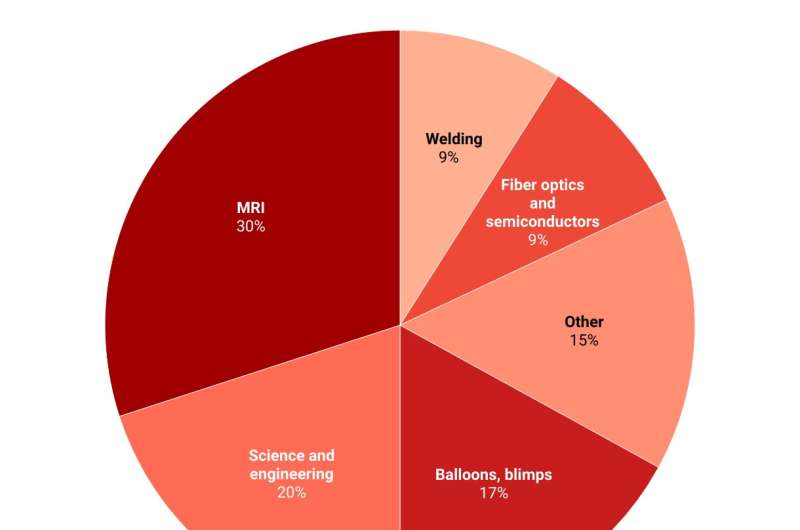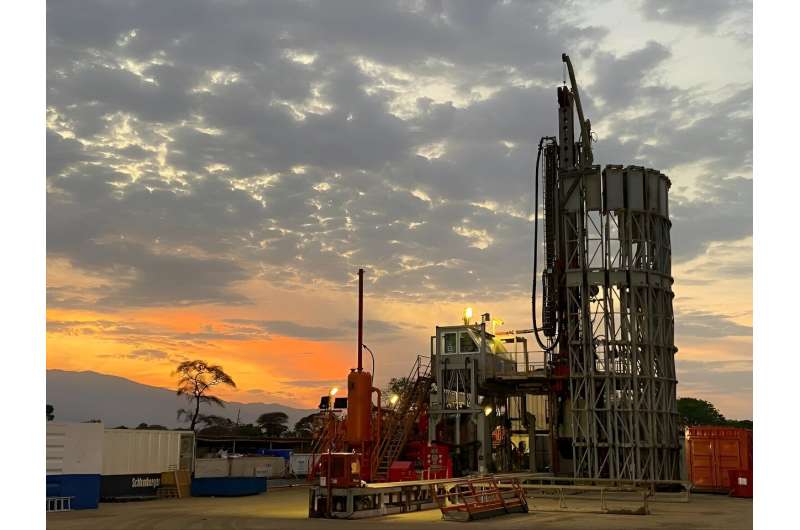This article has been reviewed according to Science X's editorial process and policies. Editors have highlighted the following attributes while ensuring the content's credibility:
fact-checked
trusted source
written by researcher(s)
proofread
Helium is essential for research, medical equipment, but it's nonrenewable and difficult to recycle

The next time you pick up balloons for your big party, remember the helium gas in those balloons is destined for the stars. Helium is so light that it easily escapes Earth's gravity, and all helium will eventually make its way into space. Like fossil fuels, helium is a limited resource.
Helium shortages have become an acute problem for many researchers. Since early 2022, a variety of factors have put pressure on the global helium market, including the potential sale of the U.S.'s publicly held helium reserves and production infrastructure, sanctions against Russia and a series of breakdowns at helium plants.
Four helium shortages have occurred over the past decade, and these disruptions affect several high-tech industries. Beyond inflating balloons, helium plays a part in welding for certain metals and in making semiconductors.
Medical imaging and chemical analysis research also use helium. Liquid helium cooled to –450°F (–268°C) keeps the superconducting magnets in instruments like magnetic resonance imaging, or MRI, and nuclear magnetic resonance, or NMR, systems cool.
Helium shortages put pressure on many industries, and when a shortage hits, helium costs can spike dramatically. Even consumers can be affected—prices for inflated party balloons and helium tank kits have increased substantially.
Helium in research: A cold conundrum
Both MRI and NMR instruments require extremely strong magnetic fields to operate. The most efficient way to generate those fields uses superconducting wire. A superconducting electrical current generates a magnetic field, and once started, these currents can continue for decades without additional electrical input.
But there is a catch. Without liquid helium, the wires quickly warm up. Over time, the helium used to cool the magnets evaporates. The superconductivity goes away, and the magnetic field dissipates.
Earlier this year, LK-99, a potential new room-temperature superconductor made headlines worldwide. Such a material, if found, could eliminate the need for helium in MRI and NMR systems.
So far, LK-99 has not produced a breakthrough in superconductivity, although scientists are still hunting for new superconducting materials.
Until scientists find a functional room temperature superconductor, MRI and NMR facilities need helium. A small to midsize university or hospital may spend US$20,000 per year on liquid helium, as every few months, their liquid helium supplies need replenishing.
Larger facilities need more, and over the past two to three years, the price of helium has doubled. Some institutions have been forced to de-energize their instruments as a result. This process shuts down the magnetic field, effectively halting the instrument's activity until the facility can buy helium again.
New helium on the horizon
One approach to address the helium shortage involves seeking additional helium sources. Helium is normally obtained as a byproduct of drilling for natural gas, since helium collects underground in pockets containing methane and other hydrocarbons.
Methane is a greenhouse gas, and burning natural gas releases carbon dioxide into the atmosphere. Methane and carbon dioxide in the atmosphere contribute to climate change.
But pockets of helium that aren't mixed with natural gas could exist in places underground. Researchers searching in Africa have identified what could be a major store of helium in Tanzania's Rukwa Region.
At least two companies are actively trying to locate these pockets, which originate from unique volcanic activity in the area. Drilling at these sites could be a more climate-friendly alternative—although any form of drilling has local environmental impacts.
As of early December 2023, the helium levels found from drilling these pockets seem promising. The most recent exploration reveals helium levels of at least 2% to 3%, more than 1,000 times normal atmospheric levels. This is on par with other drilling sites that produce helium.

Two companies are currently searching for helium in Africa, and both plan to continue searching for higher helium levels. However, independent industry assessments estimate that new helium facilities may not come online until 2025 or later.
Even so, these efforts do not solve the bigger problem—the need for a renewable helium source.
Reusing existing helium
Until scientists have reliable, room-temperature superconductors or find an unlimited helium supply, conserving available helium is the best route forward. Fortunately, this is becoming easier to do.
Researchers at Iowa State University began recycling their helium in the 1960s. Since then, this technology has become cheaper, and both the U.S. National Science Foundation and the U.S. National Institutes of Health have funded efforts to install helium recovery equipment in academic research settings.
These systems are becoming more common, even in smaller NMR facilities. And scientists, including researchers in my lab, are helping each other by sharing their experiences installing this equipment.
Helium recovery systems involve three main components. First, there is a system that transports evaporated helium from the superconducting magnets. This component monitors the evaporation rate and ensures a steady flow through the system.
Second, there is a collection system. For large facilities, this consists of a large, flexible bag. The bag expands as it collects the evaporated helium, storing it temporarily. This bag is the size of a small car, and where space is a concern, smaller facilities can use helium tanks for storage.
Third, there is a system that reliquefies the gaseous helium. This is the most expensive component, and it uses electrical energy to cool the helium. Once liquefied, the facility staff transfers the helium back to the magnets.
While the helium shortage has led to significant challenges, many scientists are optimistic about the future. Researchers continue to search for room-temperature superconductors. New helium facilities in Tanzania could increase supply. And more widespread access to helium recovery equipment is allowing scientists to conserve this valuable resource.
Provided by The Conversation
This article is republished from The Conversation under a Creative Commons license. Read the original article.![]()




















